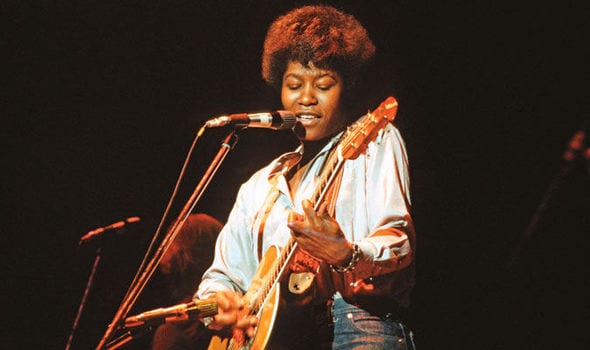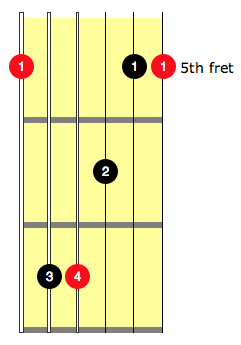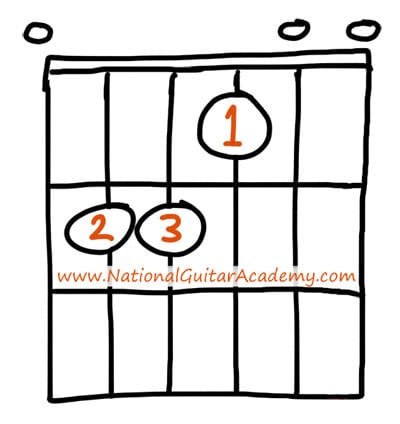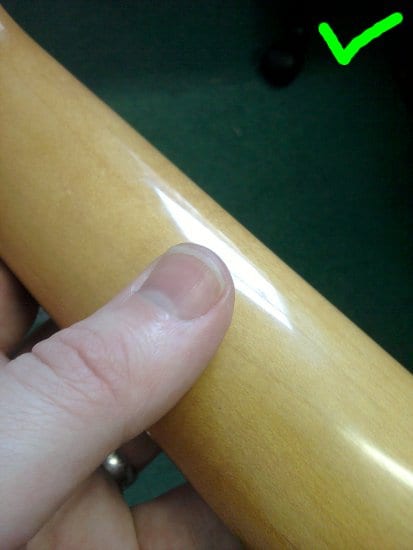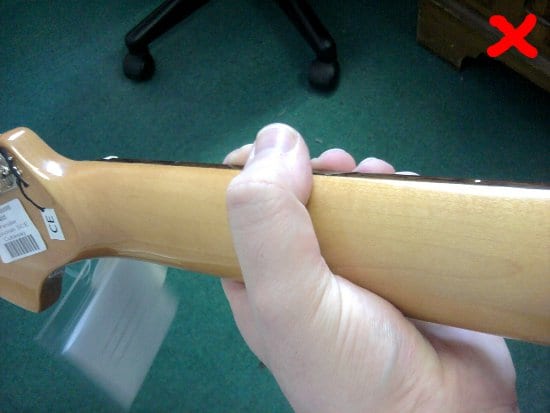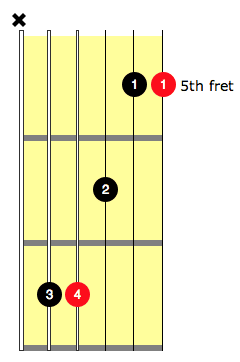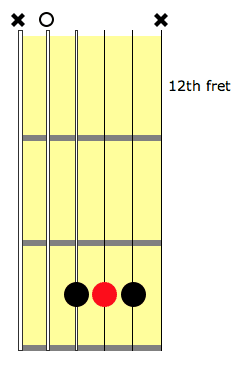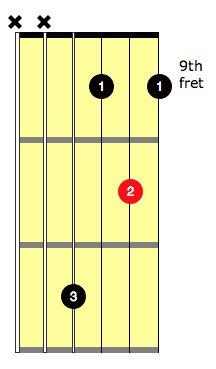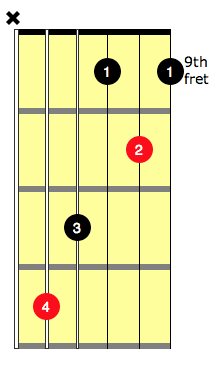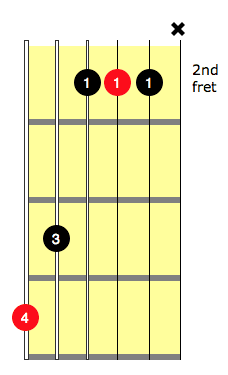Looking to learn the A bar chord? You’re in the right place!
In this free guitar lesson you will learn:
- 7 essential ways to play the A bar chord.
- 6 must-know tips for clean & easy barre chords
- The no1 secret to learning chords in ALL keys.
- 3 practice tips that will boost your guitar progress.
Over 100,000 guitar-learners get our world-class guitar tips & tutorials sent straight to their inbox:
Click here to join them Get our best guitar tips & videos
What’s the difference between the A bar chord and the normal A chord?
The difference between a bar chord and a normal chord is that the former involves us pressing down on more than one string with the same finger.
This technique is called ‘barring’.
With a ‘normal’ chord, we only press down one string with each of our fingers.
This technique of barring allows us to access chords higher up the fret board rather than confining us to the first few frets.
To learn more about barre chords, go here: Barre Chords: The Ultimate Guide
Why bother learning the A bar chord? Why not just use the normal chord?
Here are a few reasons why you should learn the A bar chord:
- Learning just one version of a chord can limit your vocabulary. As a guitarist, you must be ready for ANY musical situation.
- Different voicings of chords are more suitable for certain genres. (Higher voiced chords are perfect for funk, where as lower voiced chords are great for rock.)
- Knowing a variety of guitar chords enhances your chord knowledge.
However, most importantly bar chords are movable shapes. This means that you can play ANY chord off of just one chord shape.
Once you’ve learned the A bar chord, you’ve instantly learned 11 other barre chords. Learning barre chords makes your guitar journey easier.
In many ways, learning barre chords marks a guitarists transition from beginner to intermediate.
Want free guitar tips and video lessons delivered to your inbox?
Join over 100,000 guitar learners and subscribe to our guitar-tips-by-email service. (It's free.)
We'll send you a series of lessons that will move you to the next level of your guitar journey.
Learn how everything fits together quickly, easily and effectively. We share ninja tips (for instant fun!) but also timeless fundamentals that will deepen your understanding.


Get our best guitar tips & videos
Our Guitar Courses
To become a better guitarist click here to see our guitar courses
Get your personalised guitar-learning plan 🎸
Want us to make a guitar-learning plan that is customised to you? Click here for GuitarMetrics™
Learning The A Bar Chord
The most common way to play an A bar chord is the, “E shaped barre chord”.
Here it is:
(If you don't understand the above image please read our article "How To Read Guitar Chordboxes In 60 Seconds". It will make everything clear!)
We refer to this as the E shaped bar chord, because the shape we make with our 2nd, 3rd and 4th fingers after the bar is an E chord shape.
Let’s compare, here’s a regular E chord:
Can you see how this shape fits in within the regular A bar chord?
If you’re struggling with this chord, here’s a few tips:
Get your thumb round the back of the neck.
When playing a bar chord, your thumb should look a bit like this:
NOT like this:
In the first image, the thumb is moved down the back of the neck to the middle and is pressing the back of the neck with just the tip/print.
In the second image the thumb is wrapped round the back of the neck and is peaking out over the top of the fretboard.
It’s very difficult to keep your barring finger straight and to stretch out and form a chord shape with your other fingers with this sort of deathgrip on the neck.
Learn 12 EASY beginner chords with our popular guide


Where should we send it?
✅ Stop struggling. Start making music.
✅ Learn beginner-friendly versions of every chord.
This is our most popular guide and it will improve your chord ability quickly! 😎
Get your own personalised guitar-learning plan 🎸
Get a custom guitar-learning plan here: Click here for GuitarMetrics™
World-Class Guitar Courses 🌎
Learn from the world's best guitar educators: Click here for our guitar courses
Still Finding It Difficult? Check Out These Essential Barre Chord Tips From Mike:
Easy A Bar Chord
Here’s a easier way of playing the A bar chord.
This version of the chord leaves out the low E string. (6th string.) To play this bar chord, you only have to barre the top two strings. The B string (2nd string) and the high E string. (1st string.)
This still sounds good and can make life just that little bit easier if you’re finding the transition from normal chords to bar chords too difficult.
The important thing here though is to be careful not to strum that low E string.
That’s the catch with making chords easier for our fretting hand, sometimes it makes things more difficult for our strumming hand.
Other Types of A Bar Chord
Although the E shaped A bar chord is the most common, it’s by no means the only way of playing an A bar chord.
Let’s have a look at some other shapes.
A Bar Chord – Higher Octave Voicing
This A bar chord is exactly the same as a standard open chord. However, we’ve just moved it up 12 frets.
To play this chord:
- Place your 1st finger on the 12th fret of the A string. (5th string.)
- Barre your 3rd finger across the 14th fret of the D (4th string), G (3rd string) and B string. (2nd string.)
Alternatively you could play each string with a different finger, however it is a bit of squeeze.
The easiest way to play this chord is with your 3rd finger as a barre. This voicing of the A bar chord gives us a very bright, snappy sound and is great for styles of music like funk.
If you find this chord hard, try this voicing:
This shape is a great way to ease yourself into the idea of barring if you’re struggling to master this technique. With this shape, you only have to worry about one finger.
You can either barre this shape with your:
- 1st finger.
Or:
- 3rd finger.
The 1st finger may well be easier, plus it leaves your other fingers free to add extra notes to the chord if you’re feeling creative.
To give this chord extra oomph, you can leave the A string open.
A Bar Chord (D Shape)
This A bar chord is a variation on our standard D shape.
To play this chord:
- Barre your first finger across the G (3rd string), B (2nd string) and high E string (1st string) on the 9th fret.
- Place your 2nd finger on the 10th fret of the B string. (2nd string.)
- Place your 3rd finger on the 11th fret of the D string. (4th string.)
This is another great voicing if you’re struggling to bar across all six strings. Like the previous A bar chord, this one has a bright, percussive sound.
A Bar Chord (C Shape)
This one is very similar to the D shaped bar chord, except we’ve added an extra finger.
To play this chord:
- Barre your first finger across the G (3rd string), B (2nd string) and high E string (1st string) on the 9th fret.
- Place your 2nd finger on the 10th fret of the B string. (2nd string.)
- Place your 3rd finger on the 11th fret of the D string. (4th string.)
- Place your 4th finger on the 12th fret of the A string. (5th string.)
Notice how this chord uses the shape of a C chord after the barre. This can be a bit of a stretch so take your time with it.
A Bar Chord (G Shape)
To play this chord:
- Place your 4th finger on the 5th fret of the low E string. (6th string.)
- Place your 3rd finger on the 4th fret of the A string. (5th string.)
- Barre your 1st finger across the 2nd fret of the D (4th string), G (3rd string) and B string. (2nd string.)
If you’re struggling to reach that 5th fret with the 4th finger, you could try leaving the low E string out and just play the middle four strings.
Which A Bar Chord Should You Use?
This can depend on a number of things.
A good rule of thumb is to:
- Choose the A bar chord that is nearest to the chord you are changing from or too. Ideally you don’t want to be leaping from a chord at the 2nd fret up to a chord at the 12th fret and then back down.
Another thing that might affect your choice of A bar chord is the genre.
- For example, if you’re playing rock you may want to use a low voicing of the A bar chord.
- Or if you’re playing funk, it may be a good idea to use a higher voicing.
You might even change voicings within the same song in order to provide some variety.
How Do I Practice The A Bar Chord?
One of the best ways to practice the A bar chord is to:
- Choose a song you know with an A chord in it and try playing it using the A bar chord instead of the open A chord.
You might even find it easier to change the other chords of the song into bar chords as well.
That said, bar chords can be hard work to play at first so sometimes just sticking to one bar chord per song is a good idea.
You could also try:
- Playing the A bar chord as an arpeggio as well as strumming it. To do this, play each note in the chord separately.
When you play a chord as an arpeggio you can hear if there are any notes that aren’t ringing out clearly.
Movable Barre Chord Shapes
One of the best things about barre chords is that they are movable shapes. To change the key of a barre chord, you must change the root note of a chord.
To do this, you must move the chord to a different fret. For reference, here are ALL of the notes on a guitar:
To learn the fretboard in detail, go here:Guitar Notes Explained: A Guide For Beginners
How Do I Use This Diagram?
Okay, so let’s apply this to the E shaped A bar chord.
Let’s say that you wanted to play a Bb chord.
Currently the E shaped A bar chord starts on the 5th fret.
If you look at the diagram, the very next fret on the low E string is a Bb note. So to play a Bb chord, all you need do is move the A bar chord up a fret.
Let’s apply this to another chord, the ‘F#’ chord.
All you have to do is find where the ‘F#’ note, and move your E shaped barre chord to that fret. In this case, you will must move the A bar chord to the 2nd fret.
Pro Tip!
If you find this diagram hard to read, just concentrate on the 3rd, 5th and 7th frets. This is usually where the fret markers are on the side of a guitar neck.
To remember the note names on the low E string, just remember the phrase ‘GAB’. This relates to the note of each fret.
- G. (3rd fret.)
- A. (5th fret.)
- B. (7th fret.)
To remember the note names on the A string, just remember the phrase ‘CDE’.
- C. (3rd fret.)
- D. (5th fret.)
- E. (7th fret.)
Once you have these mastered, learning the fretboard will be a breeze.
Can I Do This With Other Chord Shapes?
Yes, this also works with the following chords:
- The A shaped barre chord.
- The C shaped barre chord.
- The D shaped barre chord.
- The G shaped barre chord.
All you have to do change the key of the chord is:
- Find the root note within your chord shape.
- Find the root note you want to go to.
- Move your shape to the new root note.
If you want to find the root note of a chord, look for the red dots within the chord diagram. This is the root note.
Take our 60-second quiz & get your results: Take The Quiz Click here to learn more about National Guitar Academy membership Look cooler! Check out our merch: Click here to see our merch store Join over 100,000 guitar-learners and subscribe to our guitar-tips-by-email service. (It's free.) We'll send you a series of lessons that will move you to the next level of your guitar journey. Learn how everything fits together quickly, easily and effectively. We share ninja tips (for instant fun!) but also timeless fundamentals that will deepen your understanding.What Type of Guitarist Are You?
Join the world's best online guitar school 🌎
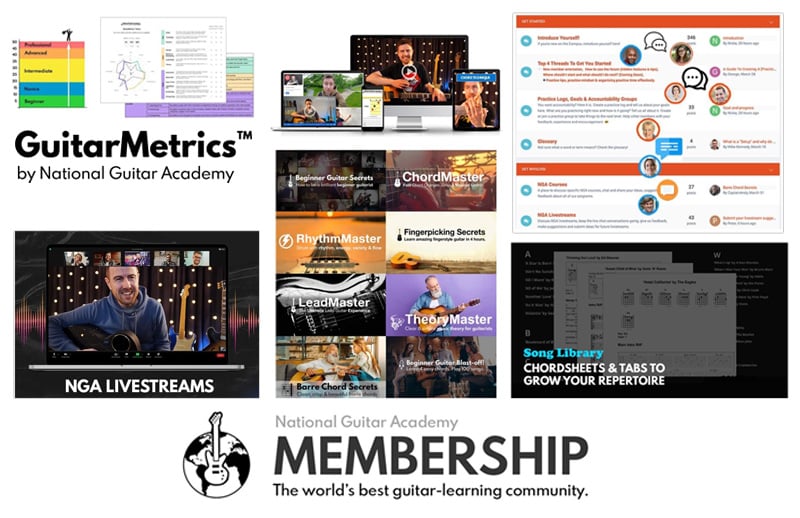
Cool Guitar T-shirts 😎
Want free guitar tips and video lessons delivered to your inbox?


Get our best guitar tips & videos
How To Learn Guitar: An 11-Step Programme For Beginners How To Choose The Perfect Beginner Guitar Learn about National Guitar Academy: About Us Join us on Facebook for daily guitar tips. Listen to our Learn Guitar Podcast for rapid guitar progress. Check out our free chord lessons.Popular Lessons
More Cool Guitar Stuff


